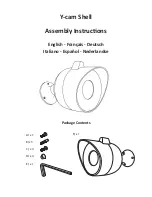
RFX150 Installation guide
The RFX150 is a replacement final RF amplification stage and low pass filter module for
use with 10 meter amateur transceivers. The RFX150 is standard equipment on certain models of
amateur transceivers, and it may also be used for repairs and upgrades on most 10 meter amateur
transceivers.
The RFX150 requires a RF input power level between 40 and 45 watts PEP for maximum
performance. RF input level less than 40 watts PEP will work, but overall power out levels will
be less.
1.
Determine that the transceiver receives and transmits properly on all modes and all
frequencies before proceeding. Repair any problems prior to installing the RFX150.
2.
Remove the transceiver covers.
3.
Unsolder and remove the antenna connector from the back of the transceiver.
4.
On transceivers with an aluminum heat sink, remove the original heat sink.
a.
This is usually accomplished by removing the two screws that are located between the
fins of the heat sink.
b.
Some transceiver heat sinks are mounted with the same screws that hold the driver and
final transistors in place, inside the transceiver. On this style transceiver you will need to
remove the screws from the inside of the transceiver that are holding the transistors. After
removing the heat sink, use the three supplied nuts to secure the transistors back into
place. THIS IS REQUIRED. If the screws are not properly reinstalled the transistors will
overheat and fail.
5.
Position the RFX150 spacer on the back of the transceiver as shown in Figure 1. Note that
the spacer is positioned so that the hole where the antenna connector was removed is partially
covered by the spacer, but allows enough room to route the wires from the RFX150 into
transceiver. In Figure 1, note how the spacer clears the screws that are mounting the
transistors inside the transceiver (if applicable) and that the spacer is flat against the back of
the chassis. This is critical to insure proper heat dissipation of the transceiver’s internal
transistors since the spacer is designed to act as a heat sink.
6.
Decide which four holes will be used to hold the RFX150 and spacer in place on the radio by
verifying any clearance issues that you see. It is suggested to use the outer most four corner
holes that are in the spacer and heat sink. Mark the four holes using the spacer as a template.
Remove the spacer and drill the four holes on the rear chassis. WARNING: Make sure not to
leave any drill shavings in the transceiver.
7.
Apply a generous amount of heat sink compound (thermal grease) on the back of the
transceiver chassis where the spacer will touch to insure good heat transfer. Position the
spacer in place.
8.
Route the blue wire and the coax cable through the antenna connector hole.
9.
Locate the four threaded mounting rods and cap nuts. Screw the four cap nuts onto one end
of each of the four threaded mounting rods. It is highly recommended to use thread lock so
that the cap nuts do not come loose.
10.
Mount the RFX150 and spacer to the back of the transceiver by passing the assembled
threaded mounting rods through the chosen mounting holes in the RFX150, spacer and into




















